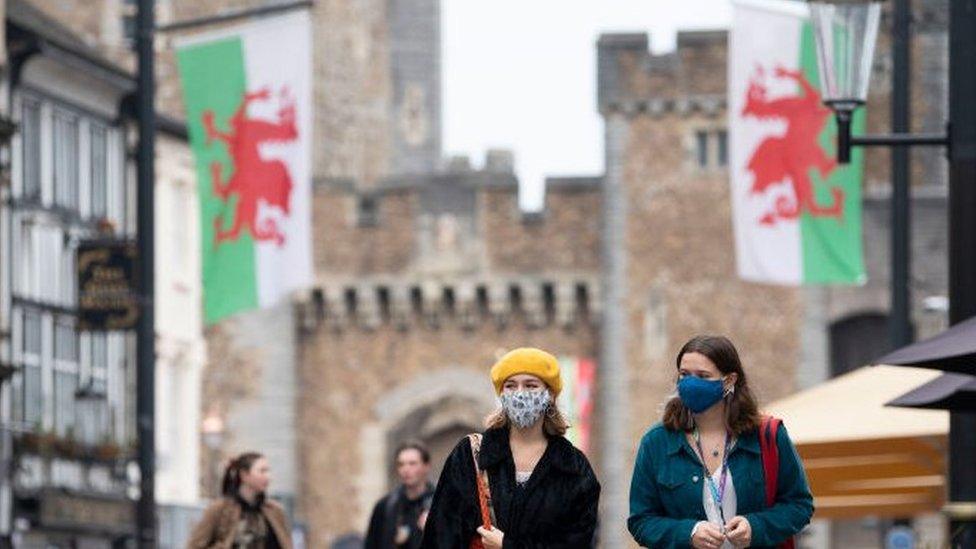Covid: Your coronavirus pandemic in Wales questions answered
- Published

Over the past week, BBC Wales has asked readers to submit their questions about the coronavirus pandemic in Wales.
We asked if there was anything you wanted to know and whether the rules are confusing you - and pledged to try and answer.
Here's what you wanted to know.

"The death rate states that it includes all people that test positive in the last month but how many have actually died directly from Covid?"
People die with coronavirus, not of coronavirus - just as people die with cancer, not of cancer.
That is because the actual cause of death is the effect the virus - or cancer - has on the body.
For example, Covid-19 can cause a huge degree of inflammation which becomes multi-organ failure and this is the cause of death.
Similarly some cancers can, for example, damage blood vessels which causes bleeding in the brain - a stroke - which can be fatal.
Therefore the damage to the body which causes death has been caused by coronavirus, but coronavirus is not the direct cause of death - the cause of death in this example would be organ failure.
So the deaths are with, not of, coronavirus.
In recording deaths with Covid-19, medical professionals will consider: "Would this person be alive today if they had not caught coronavirus?"
It has been estimated by the Office for National Statistics (ONS) that 88.9% of deaths in Wales where doctors have mentioned Covid-19 on the death certificate, that it was the underlying cause of death.
So in October, 236 deaths were due to Covid-19. But there were another 49 when Covid-19 was involved and mentioned on the death certificate, and a factor in the death.
In Wales, Covid-19 was the underlying cause of death in 2,629 of deaths registered up to 7 November.
It is important to note the figures released daily by Public Health Wales or weekly by the ONS do not include all people who have tested positive in 28 days.
Rather, they include people who have had confirmed or suspected coronavirus within the past 28 days which is believed to have been a factor in their death.
"Is there any reason I should catch Covid if my extended household all work from home, rarely go out, are careful and play by all the rules?"
Taking safety measures such as working from home, staying home as much as possible and respecting the rules will put you in the best position to avoid the virus.
However, anyone can catch coronavirus and anyone can pass it on.
It only takes one interaction with someone who may not even realise they are infected to potentially catch coronavirus.
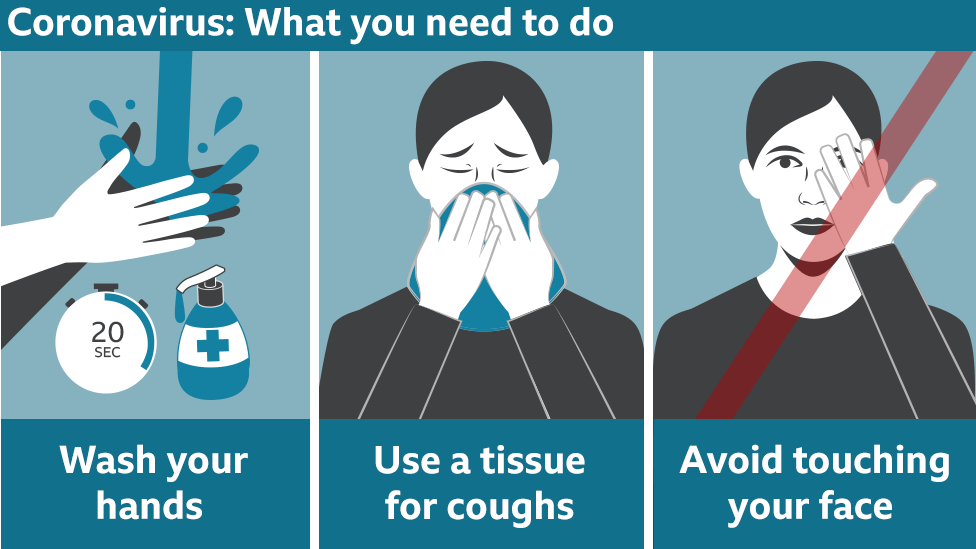
While coronavirus is mostly transmitted when people cough, sneeze or talk, there are also some studies showing it can be transmitted by touching an infected surface - such as on groceries or packages delivered to your home.
These studies have mostly been done in lab conditions and some experts have thrown doubt on the actual threat posed by surface transmission in real life.
Either way - to best protect yourself from catching coronavirus from surfaces, regularly wash your hands for 20 seconds.
"If there is a wide uptake of vaccination would all of the basic measures such as masks and social distancing still apply?"
If and when a vaccine (or more than one vaccine) is approved for use in the UK and begins to be rolled out, safety measures such as those you've listed will still need to be in place for some time.
That's because it will take months to vaccinate everyone who wishes to be vaccinated.
As you've correctly implied, there are still questions over whether uptake of the vaccine will be high due to misinformation and myths on social media, and there may be some people who cannot be vaccinated for medical reasons.
We have fact checked some of the most widely shared false claims.
Even if the uptake is good, we are likely to be well into 2021 before all the relevant groups have been offered the vaccination - which will probably begin with front-line NHS staff and care staff, followed by the elderly and others most vulnerable to the virus.
So we'll need to continue taking safety measures for the time being.
It is early days, but it's likely the Welsh Government will continue to look at infection rates the way they have been doing since the beginning of the pandemic, and allow these measures to be dropped when scientific advisers believe it is safe to do so.
"Why has the country been 'shut down' when out of a population of more than three million, about 3,000 people have died?"
It has been recognised throughout the pandemic that Welsh people have made sacrifices and continue to make sacrifices - and Mark Drakeford has repeated during news briefings that every death is a tragedy.
In making decisions over lockdown measures, the Welsh Government looks at several factors including the R number - the average number of people a sick person could pass the virus on to.
The aim of lockdowns is to reduce the R number below one, which means case numbers would begin to fall - therefore fewer people are getting ill, leading to fewer hospital admissions so the NHS does not become overwhelmed, and fewer deaths.
Lockdown restrictions since March, along with social distancing and other safety measures, have served to shrink the R number.
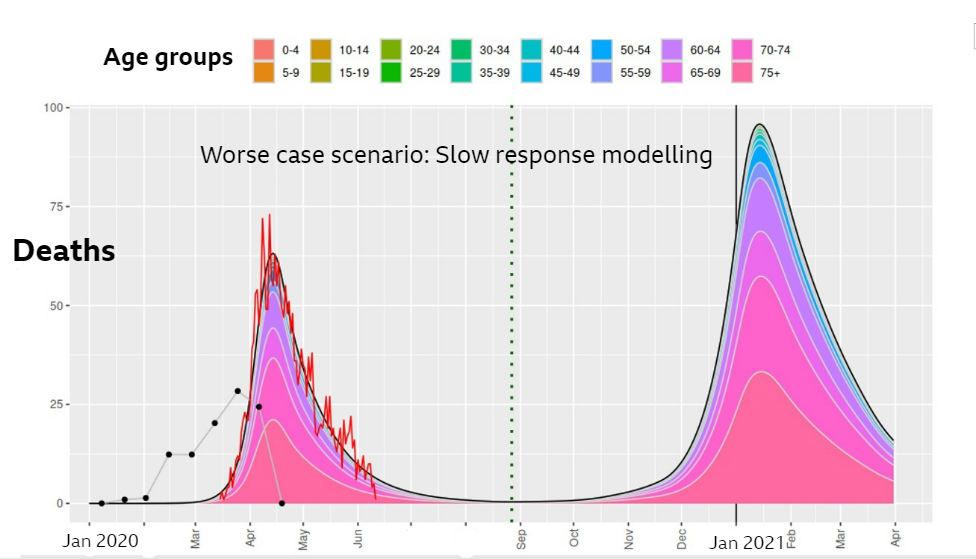
This modelling chart looks at the worse case scenario for deaths by day, if there is a slow response in Wales
However, as the country has moved out of lockdowns, the R number has risen again.
In September, a "reasonable worst case scenario" for this winter was published by Swansea University experts, mentioning 636,000 infections, leading to 18,200 hospital admissions - peaking in January - and potentially 6,300 deaths.
If the NHS becomes overwhelmed, this does not just affect Covid patients but it restricts the organisation in how well other services such as cancer referrals and A&E can operate.
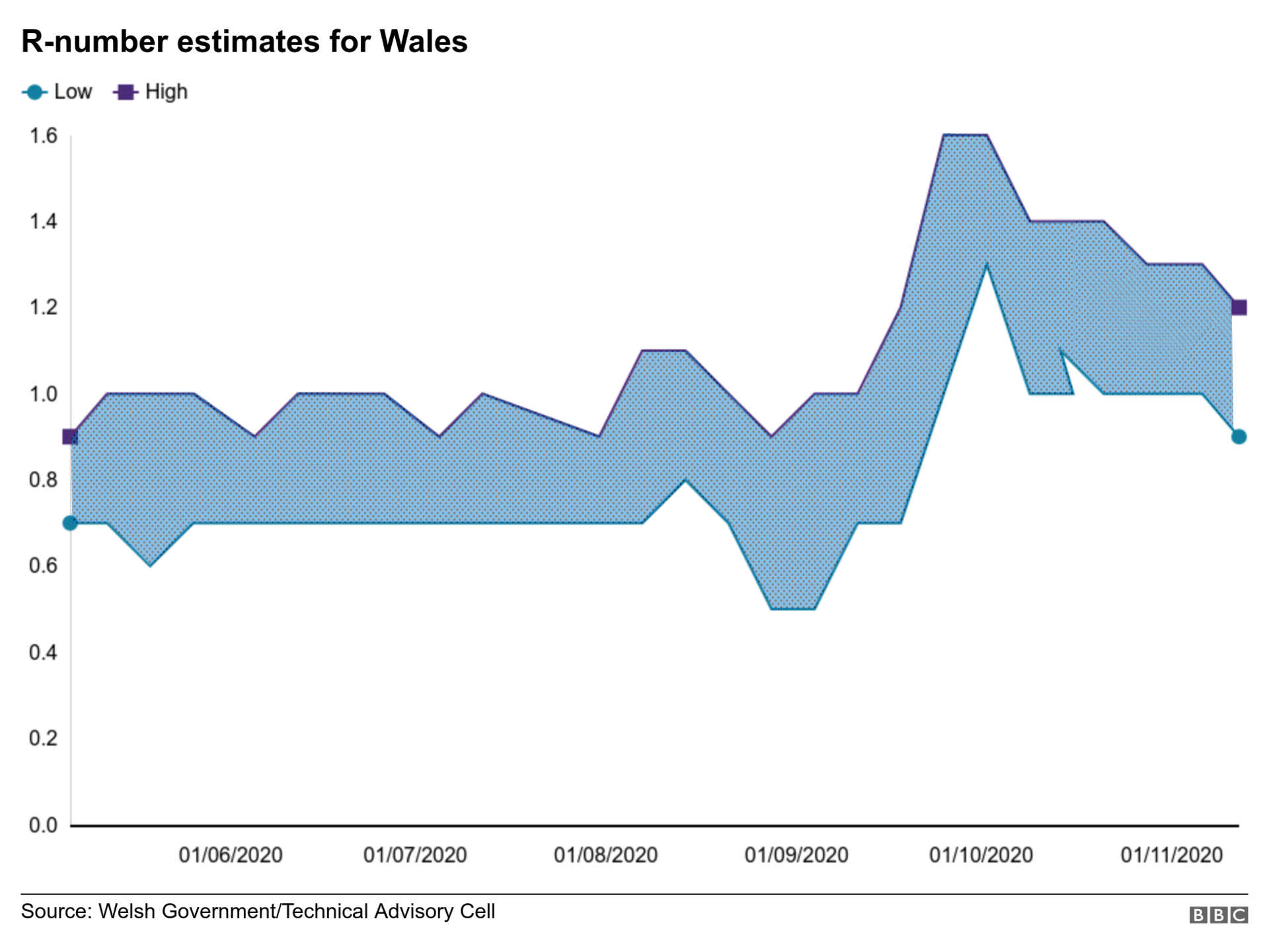
This shows how the range of the R-number has changed in Wales. The Welsh Government's latest estimate is that it could be as high as 1.4
"What will be the long-term health risks based on the delays to planned operations and cancer treatments?"
It is expected to take years before NHS waiting times are back to pre-coronavirus levels in Wales, according to the organisation's boss.
The number of people waiting more than 36 weeks for planned hospital treatments is six times higher than at the start of 2020.
Waiting list figures, published in November for the first time since March, showed nearly 169,000 people waiting.

The number has grown after most non-urgent treatment was postponed to prepare the NHS for the first coronavirus wave.
Since then, the service has been trying to restart non-emergency treatments and aims to keep them going as much as possible during the second wave.
The fear, of course, is that people who have missed out on early intervention as a result will have missed an opportunity for early treatment - such as in the case of Simon Green whose scan was delayed and brain tumour subsequently found to be inoperable.
Why this cancer patient feels coronavirus has 'cost me a future'
As a result of such delays, Prof Tom Crosby of the Wales Cancer Network said as many as 2,000 people could die.
The Welsh Government said work was under way to address the issue with health boards.
But there are fears had such measures not been taken to reduce pressures on the NHS, the organisation could have been overwhelmed - which would also result in deaths.
"Not acting would have meant that not only would the health service have been overwhelmed with very poor care of Covid and non-Covid patients, but it also would have been disastrous for our staff," Vaughan Gething said.
"Why do we use anti-bacterial hand sanitisers when Covid-19 is a virus?"
Bacterial infections and viruses are different and, for example, antibiotics only work on bacterial infections and not viruses.
However, anti-bacterial hand sanitisers or cleaning products can also be effective on some viruses if the alcohol concentration is high enough.
Viruses similar to the structure of coronavirus are sensitive to alcohol and detergents, which can help break down their oily, fatty shells.
Hand washing with soap is still the best cleaning practice, according to the NHS.
"I would like to know if there is any evidence to demonstrate where most transmissions are occurring, eg between houses, shops, pubs, school?"
This data is not routinely released, and there could be data protection issues if it were. But local authorities and the Welsh Government have occasionally referenced why lockdown measures have needed to be tightened in certain areas.
For example, schools in Cardigan have closed for two weeks after a spike in cases in the area, with Ceredigion council leader Ellen ap Gwynn blaming "super-spreader events" such as "parties" and "pub crawls".
When parts of the south Wales valleys were placed under stricter lockdown measures, transmissions were believed to have been occurring due to people going into each others' homes and not adhering to social distancing.
And measures have been taken in hospitals and care homes when there is evidence of transmission there.
So while this data is not routinely made available to the public, when it leads to specific decisions on restrictions, an explanation is usually given.
"Has or did the Welsh firebreak have any effect in bringing down cases in Wales?"
While it takes a few weeks or even longer to fully understand the impact any change in restrictions has made, there are promising early signs the firebreak has helped, the Welsh Government says.
The chief medical officer's analysis said the evidence was now "good enough" that it did "succeed".
Mark Drakeford said the amount of people with coronavirus in hospital was "stabilising".
"What we need to see is incidence in the community falling and that translating into falling numbers of people in hospital or needing critical care," he added.
"We're seeing the first signs of the growth of people in hospital beds reducing and bed numbers stabilising.
"What we have to do is build on that and make sure we don't fritter all that away by going back to the behaving in ways that will drive those numbers back up again."
Plaid Cymru said the Welsh Government should be taking steps to ensure there was no need for another national lockdown.
"With the end of the lockdown in England, can I travel to England?"
Yes - to some areas.
Travel in and out of Wales from England was previously banned unless you had a valid and essential reason, but Welsh Government rules updated on 3 December have changed this.
From 18:00 GMT on Friday, travel is only banned between Wales and tier 3 areas of England and tier 3 and 4 areas of Scotland and Northern Ireland.
This means you are now able to travel to and from tier 1 and 2 areas - replacing the previous blanket travel ban - although the government strongly advises against travelling to those areas at all.
Here's how to find out which tier an area of England is in.
Between 23 and 27 December, you can travel anywhere in the UK to form your Christmas bubble.
"Many people suffered last Christmas with Covid symptoms. Is it possible we have had it?"
There were calls earlier this year for a spike in excess deaths in January and February in Ceredigion to be investigated.
In the first 17 weeks of the year 342 deaths were registered in Ceredigion, according to figures obtained by Newyddion S4C - 22% more than the five-year average.
MP Ben Lake wanted to know if Covid-19 was present before it was realised.
Cardiff University's Rhian Daniel said this was not "highly likely" and was likely due to a similar infection.
However, due to antibodies potentially fading to undetectable levels a few months after infection, taking an antibody test now probably wouldn't identify whether that virus you had last winter really was Covid-19 or another virus causing similar symptoms.
Scientists and doctors in some European countries have claimed to have found evidence of coronavirus circulating earlier than previously thought.
And with evidence of coronavirus arriving in the UK on at least 1,300 separate occasions, we may never know exactly when the UK saw its patient zero.
"Why do some people get mild symptoms and others are struggling months later?"
Long Covid has now been recognised as a medical condition, and healthcare workers are receiving guidance on it.
There is no medical definition or list of symptoms shared by all patients - two people with long Covid can have very different experiences.
However, the most common feature is crippling fatigue.
Others symptoms include: breathlessness, a cough that won't go away, joint pain, muscle aches, hearing and eyesight problems, headaches, loss of smell and taste as well as damage to the heart, lungs, kidneys and gut.
Mental health problems have been reported including depression, anxiety and struggling to think clearly.
It can utterly destroy people's quality of life, and it is not necessarily people who were severely ill in hospital who are struck by it.
Even people with relatively mild infections can be left with lasting and severe health problems.
"Why is it called Covid 19? Is there an 18 or a 20?"
Covid-19 simply references the year the virus was first identified in Wuhan - 2019.
Official names were announced for the virus responsible for Covid-19 - previously known as "2019 novel coronavirus".
The virus is called severe acute respiratory syndrome coronavirus 2 (SARS-CoV-2), and the illness it causes is called coronavirus disease (Covid-19).
Referencing the word SARS has been avoided by the World Health Organisation, external due to its potential for spreading fear, especially in Asia which was worst affected by the SARS outbreak in 2003.
- Published2 April
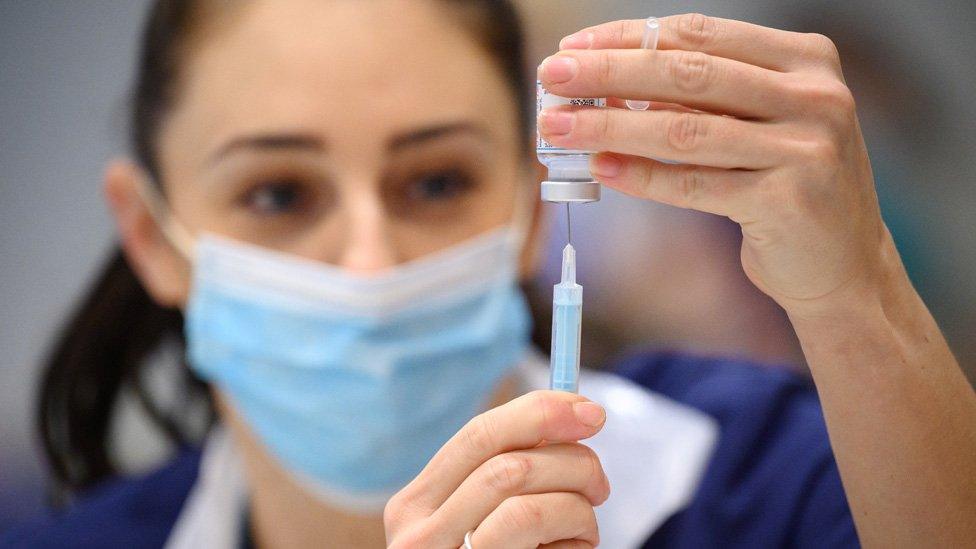
- Published26 March 2021
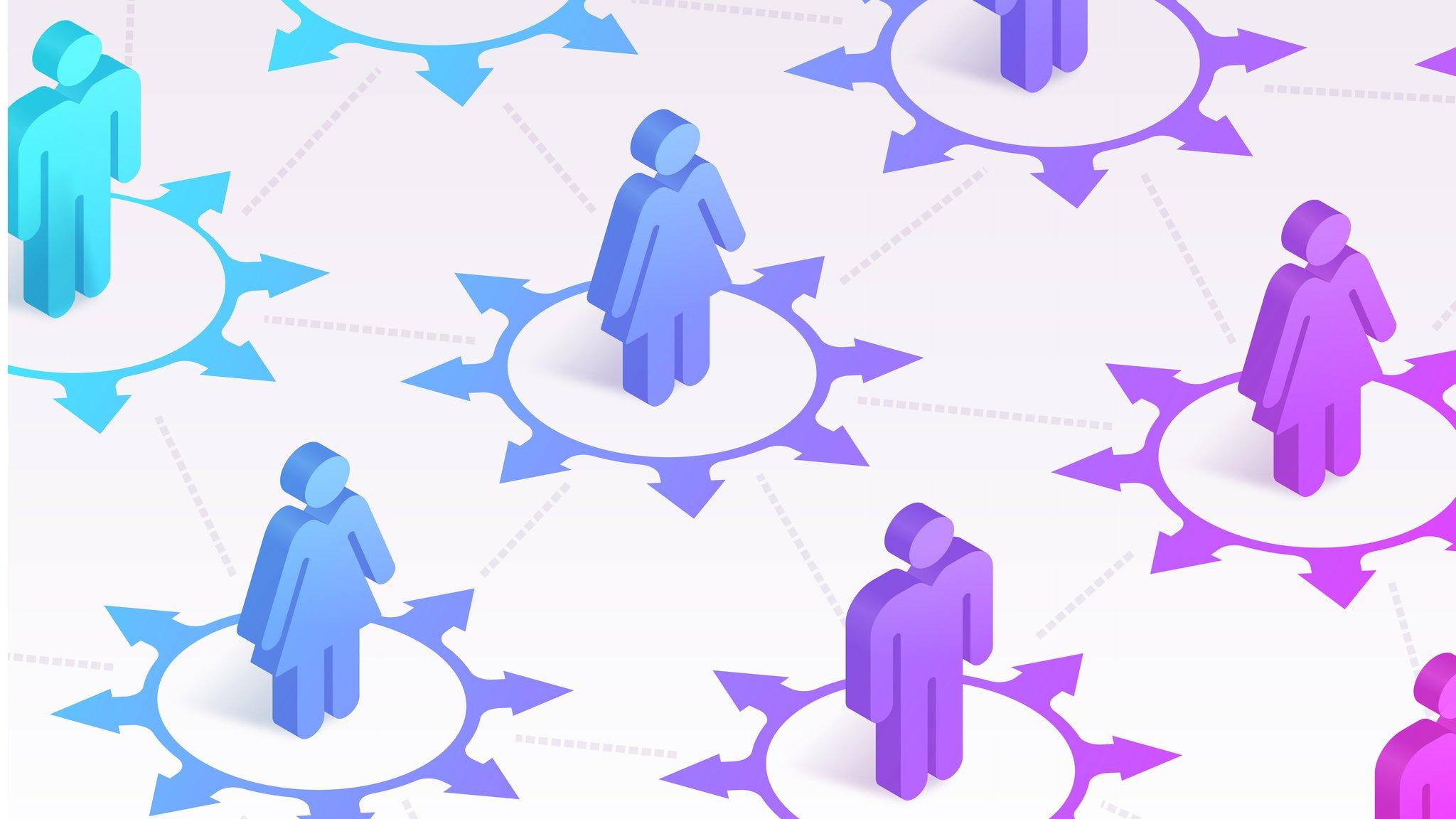
- Published23 November 2020
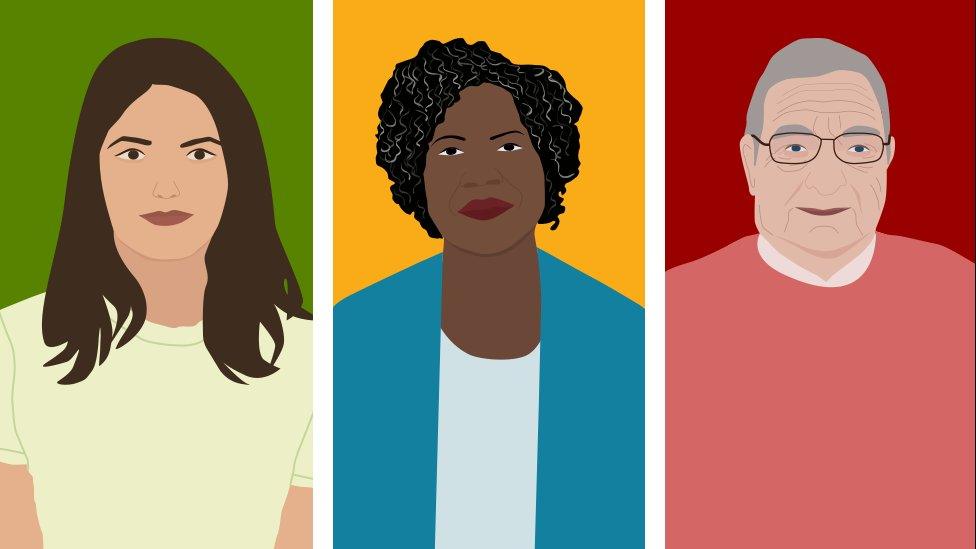
- Published23 November 2020
